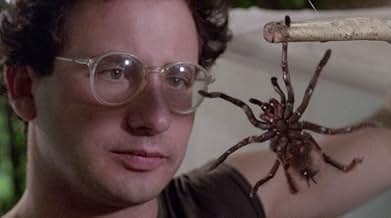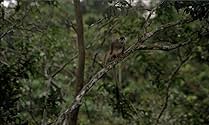NOTE IMDb
4,0/10
1,1 k
MA NOTE
Ajouter une intrigue dans votre langueFour friends head into the jungle to locate a lost professor but instead face off against treasure hunters who are torturing and killing natives.Four friends head into the jungle to locate a lost professor but instead face off against treasure hunters who are torturing and killing natives.Four friends head into the jungle to locate a lost professor but instead face off against treasure hunters who are torturing and killing natives.
- Réalisation
- Scénario
- Casting principal
Avis à la une
I was previously familiar with the 1988 Italian movie "Paradiso Infernale" by its English title "The Green Inferno" and I remember having seen the movie once, many, many years ago. So as I had the opportunity to sit down to watch the movie again here in 2023, I opted to do so. And I have to admit that I had fully and wholly forgotten about the storyline of the movie.
It sort of amazes me that writers Antonio Climati, Marco Merlo, Francesco Prosperi, Federico Moccia and Lorenzo Castellano could collectively manage to put together such a weak script and storyline for a movie. I suppose that five writers and creative minds working on a script just simply was diluting the creative output.
I found very little entertainment in "Paradiso Infernale", and I guess that is why I had forgotten all about the storyline here, because there was nothing noteworthy to be witnessed throughout the course of the 90 minutes that the movie ran for.
The acting performances in "Paradiso Infernale" were adequate enough. Needless to say that I wasn't familiar with the cast ensemble.
"Paradiso Infernale" is not a particularly outstanding movie experience, and for a movie such as this, with a cannibal theme, then there are actually far better and more enjoyable movies out there from around that same era of cinema.
My rating of "Paradiso Infernale" lands on a three out of ten stars.
It sort of amazes me that writers Antonio Climati, Marco Merlo, Francesco Prosperi, Federico Moccia and Lorenzo Castellano could collectively manage to put together such a weak script and storyline for a movie. I suppose that five writers and creative minds working on a script just simply was diluting the creative output.
I found very little entertainment in "Paradiso Infernale", and I guess that is why I had forgotten all about the storyline here, because there was nothing noteworthy to be witnessed throughout the course of the 90 minutes that the movie ran for.
The acting performances in "Paradiso Infernale" were adequate enough. Needless to say that I wasn't familiar with the cast ensemble.
"Paradiso Infernale" is not a particularly outstanding movie experience, and for a movie such as this, with a cannibal theme, then there are actually far better and more enjoyable movies out there from around that same era of cinema.
My rating of "Paradiso Infernale" lands on a three out of ten stars.
I'm having trouble classifying Natura Contro aka The Green Inferno from 1988 correctly. Was this an adventure movie meant for Indiana Jones fans? Or a Cannibal film for fans of Cannibal Holocaust?
There is a bit of both in it and that immediately means that you also have to love both to find this one working for you.
The plot summed up: a group of American adventurers takes a stolen plane into the South American jungle to find a professor and his discovery (a treasure in a jungle village). Along the way, they must capture Monkeys to buy gasoline for the plane, capture Anacondas to get a raft, and save an Indian village from Jungle Pirates who kidnap children to trade their organs for dollars!
What this film certainly has in common with Indiana Jones is its very Hollywood, simplistic view of the rest of the world. Indian tribes in South America, who I think probably can't even speak Spanish or Portuguese, turn out to be perfectly fluent in English. They let themselves be bribed with a tape recorder because the tape has a recording of Jungle Sounds (Yeah, you don't hear that often in the Jungle...) And the women walk around in monokini, but put on clothes when they go out with the Americans (because so the Americans wouldn't feel uncomfortable?). I think as a viewer it is best not to ask too many questions.
The lite, at times almost funny style of adventure (which seems to come from a children's film) is in stark contrast to the sometimes very cruel things that happen around. All the gore that should have made this a horror movie remains out of the picture, but castrating a man with a snake, for example, is still quite dramatic and serious. The characters lack the shock you would expect after seeing this happen.
So my biggest problem is the characters' lack of realism in relation to their condition. I'm not saying that the actors do a bad job, they just act like they're in a romantic comedy and not in a alive/dead situation. Weird! Another minor problem is that I suspect this too is a movie first filmed in Italian and then dubbed into English. As there is just a little something wrong with the lip syncro... I much prefer that movies just keep the Italian spoken and opt for subtitles. The masses, which this film probably aimed at in the US, will probably prefer a dub.
Other than that, the film isn't all that bad: the jungle is beautifully filmed and the plot, although a bit cheezy, is quite interesting and fun. I have the strong impression that they first wanted to make a Cannibal Horror film, and then they changed their mind. Scary scenes and gross was omitted and the characters became pranksters and young do-gooders. It just watered down to what it is.
How many points should I give to this film? Difficult! As Horror? Not even 3/10 because there is hardly anything left of it. As an adventure film? Actually, Natura Contro is not doing so badly: the film is adventurous and the characters know how to arouse the viewer's interest.
So 6/10, it's interesting for fans of 80s adventure movies but don't expect any horror!
There is a bit of both in it and that immediately means that you also have to love both to find this one working for you.
The plot summed up: a group of American adventurers takes a stolen plane into the South American jungle to find a professor and his discovery (a treasure in a jungle village). Along the way, they must capture Monkeys to buy gasoline for the plane, capture Anacondas to get a raft, and save an Indian village from Jungle Pirates who kidnap children to trade their organs for dollars!
What this film certainly has in common with Indiana Jones is its very Hollywood, simplistic view of the rest of the world. Indian tribes in South America, who I think probably can't even speak Spanish or Portuguese, turn out to be perfectly fluent in English. They let themselves be bribed with a tape recorder because the tape has a recording of Jungle Sounds (Yeah, you don't hear that often in the Jungle...) And the women walk around in monokini, but put on clothes when they go out with the Americans (because so the Americans wouldn't feel uncomfortable?). I think as a viewer it is best not to ask too many questions.
The lite, at times almost funny style of adventure (which seems to come from a children's film) is in stark contrast to the sometimes very cruel things that happen around. All the gore that should have made this a horror movie remains out of the picture, but castrating a man with a snake, for example, is still quite dramatic and serious. The characters lack the shock you would expect after seeing this happen.
So my biggest problem is the characters' lack of realism in relation to their condition. I'm not saying that the actors do a bad job, they just act like they're in a romantic comedy and not in a alive/dead situation. Weird! Another minor problem is that I suspect this too is a movie first filmed in Italian and then dubbed into English. As there is just a little something wrong with the lip syncro... I much prefer that movies just keep the Italian spoken and opt for subtitles. The masses, which this film probably aimed at in the US, will probably prefer a dub.
Other than that, the film isn't all that bad: the jungle is beautifully filmed and the plot, although a bit cheezy, is quite interesting and fun. I have the strong impression that they first wanted to make a Cannibal Horror film, and then they changed their mind. Scary scenes and gross was omitted and the characters became pranksters and young do-gooders. It just watered down to what it is.
How many points should I give to this film? Difficult! As Horror? Not even 3/10 because there is hardly anything left of it. As an adventure film? Actually, Natura Contro is not doing so badly: the film is adventurous and the characters know how to arouse the viewer's interest.
So 6/10, it's interesting for fans of 80s adventure movies but don't expect any horror!
Antonio Climati is a man who will be remembered for one thing and one thing only: spectacularly contentious mondo films. During the 70s and early 80s, Climati produced a handful of some of the most unpleasant movies ever committed to celluloid, all in the name of "documentary". It was his 1976 film THIS VIOLENT WORLD that directly inspired some of the scenes in Deodato's exploitation classic CANNIBAL HOLOCAUST, a film which dealt a critical blow to the mondo genre. With the similarities between mondo and the violent jungle travelogue approach of the classic cannibal movie, it seems only fitting that Climati would finally try his hand at it too. Ironically, his film has clearly been strongly influenced by CANNIBAL HOLOCAUST, right down to the title...
Cannibal movie fans will immediately recognise the plot devices used in THE GREEN INFERNO from Deodato and Lenzi's past frolics in the jungle. However, it had one main difference- it was made ten years after the "golden era" of the genre. This is greatly reflected in the violence of the movie, which is enormously toned down. Whilst the "westerners captured by natives" plot remains perfectly in line with the most generic cannibal movie, there is no actual cannibalism in the picture and gore is kept to an absolute minimum. Similar to Deodato's CUT AND RUN, THE GREEN INFERNO treads the boards of a cannibal pictures whilst carefully avoiding cannibalism.
This isn't the only cannibal convention that has been sacrificed here. One of the most controversial aspects of the genre is the depiction of cruelty against and the killing of animals. Amazingly in THE GREEN INFERNO, these are replaced with scenes of COMPASSION towards animals! In one scene, a monkey is revived by the exploring party... and in total shades of CANNIBAL HOLOCAUST, at another point, a turtle is pulled out of a water tank, only to be replaced unharmed.
One has to wonder what Climati's intentions were. The awkward "anti-animal cruelty" stance that the movie seems to adopt would be easier to appreciate if one hadn't seen Climati's previous work. Movies such as SAVAGE MAN... SAVAGE BEAST positively reveled in horrifically drawn-out scenes of animal killing, so what could have changed in the meantime? In honesty, many of the animal scenes are still clearly cruel and putting the subjects under distress. This makes Climati's stance quite transparent. I honestly believe he was attempting to criticise the cannibal genre just as Deodato had damningly and directly criticised him in the past. This was also coupled with the chronological fact that audiences were simply less willing to watch animals being butchered with machetes by the time this flick was made.
As a movie, THE GREEN INFERNO is competently made yet somewhat forgettable. It has the same atmosphere as the earlier genre entries, but comes across as being rather watered down. The sound-track, photography and dialogue are all utterly perfunctory, and besides the animal issues mentioned already, a genre veteran can quite easily predict the entire plot after a few short minutes. However, in a way it is a fittingly odd end to an extremely strange genre of exploitation cinema- anaemic, bitter, and self-referentially critical.
Cannibal movie fans will immediately recognise the plot devices used in THE GREEN INFERNO from Deodato and Lenzi's past frolics in the jungle. However, it had one main difference- it was made ten years after the "golden era" of the genre. This is greatly reflected in the violence of the movie, which is enormously toned down. Whilst the "westerners captured by natives" plot remains perfectly in line with the most generic cannibal movie, there is no actual cannibalism in the picture and gore is kept to an absolute minimum. Similar to Deodato's CUT AND RUN, THE GREEN INFERNO treads the boards of a cannibal pictures whilst carefully avoiding cannibalism.
This isn't the only cannibal convention that has been sacrificed here. One of the most controversial aspects of the genre is the depiction of cruelty against and the killing of animals. Amazingly in THE GREEN INFERNO, these are replaced with scenes of COMPASSION towards animals! In one scene, a monkey is revived by the exploring party... and in total shades of CANNIBAL HOLOCAUST, at another point, a turtle is pulled out of a water tank, only to be replaced unharmed.
One has to wonder what Climati's intentions were. The awkward "anti-animal cruelty" stance that the movie seems to adopt would be easier to appreciate if one hadn't seen Climati's previous work. Movies such as SAVAGE MAN... SAVAGE BEAST positively reveled in horrifically drawn-out scenes of animal killing, so what could have changed in the meantime? In honesty, many of the animal scenes are still clearly cruel and putting the subjects under distress. This makes Climati's stance quite transparent. I honestly believe he was attempting to criticise the cannibal genre just as Deodato had damningly and directly criticised him in the past. This was also coupled with the chronological fact that audiences were simply less willing to watch animals being butchered with machetes by the time this flick was made.
As a movie, THE GREEN INFERNO is competently made yet somewhat forgettable. It has the same atmosphere as the earlier genre entries, but comes across as being rather watered down. The sound-track, photography and dialogue are all utterly perfunctory, and besides the animal issues mentioned already, a genre veteran can quite easily predict the entire plot after a few short minutes. However, in a way it is a fittingly odd end to an extremely strange genre of exploitation cinema- anaemic, bitter, and self-referentially critical.
Paradiso infernale got one great weakness - it lacks almost on all fields: there is not enough gore, not enough sleaze, not enough action, not enough cheese. What we mostly get are some cliched and watered down copy scenes of "serious" cannibal movies like Cannibal Ferox and Cannibal Holocaust, one could dare to say this one is made for a mainstream audience and taken away is most of the "spice" of such kind of trashy movies. To make things worse many of the scenes feel very disjointed, somewhat it looks that every idea that crossed the minds of the writers was somewhat squeezed in. Anyway, the flick got some funny scenes and there is some cheesy feel of a cheap Indiana Jones movie, so if you are on the trip to watch everything "cannibalistic" you can put this one on your to watch list, it won't kill you - neither by total joy nor by total boredom.
Green Inferno (AKA Cannibal Holocaust II) is what you get if you suck all of the visceral power (and the cannibalism) out of Cannibal Holocaust. Like Deodato's infamous shocker, the film sees an intrepid female reporter and her team venture into the jungles of the Amazon to try and find a missing professor of anthropology. Unlike Deodato's film, it features no gruelling horror (unless you count the sight of a small carnivorous fish being extracted from a man's ass!), instead coming across like a National Geographic documentary crossed with a lame jungle adventure (with elements of humour). It certainly doesn't deserve to be associated with the king of all Italian cannibal movies.
Much of the film revolves around the protagonists stealing a plane and then trapping monkeys which they exchange for gas; this allows director Antonio Climati to include that genre staple -animal cruelty - but even these scenes lack the ability to shock or disgust (it's a wonder why he held back given his involvement with notorious mondo movies Africa Addio and Savage Man Savage Beast, both of which feature loads of animal violence). After successfully fuelling their stolen plane, the characters have a run in with angry natives that amounts to nothing, are attacked by bats, meet a topless jungle beauty, are captured by river pirates who are harvesting the organs of indigenous children, and eventually locate the missing professor, who is perfectly fine. No cannibalism involved whatsoever.
Much of the film revolves around the protagonists stealing a plane and then trapping monkeys which they exchange for gas; this allows director Antonio Climati to include that genre staple -animal cruelty - but even these scenes lack the ability to shock or disgust (it's a wonder why he held back given his involvement with notorious mondo movies Africa Addio and Savage Man Savage Beast, both of which feature loads of animal violence). After successfully fuelling their stolen plane, the characters have a run in with angry natives that amounts to nothing, are attacked by bats, meet a topless jungle beauty, are captured by river pirates who are harvesting the organs of indigenous children, and eventually locate the missing professor, who is perfectly fine. No cannibalism involved whatsoever.
Le saviez-vous
- AnecdotesA real monkey is actually blow-darted in the film, resulting in 12 seconds being cut from the UK release. Despite this, however, there are no animal deaths, which is rare for an Italian-exploitation cannibal movie.
- Versions alternativesThe film was originally passed in the UK by the BBFC in August 2002 with a '15' rating under the title "Cannibal Holocaust 2" (shorn of 12 seconds for alleged animal cruelty). It was passed uncut (with its previous cuts waived) in widescreen, again with a '15' rating, in September 2018.
- ConnexionsFeatured in The Cinema Snob: Cannibal Holocaust II (2017)
Meilleurs choix
Connectez-vous pour évaluer et suivre la liste de favoris afin de recevoir des recommandations personnalisées
Détails
- Durée1 heure 30 minutes
- Couleur
- Mixage
- Rapport de forme
- 1.85 : 1
Contribuer à cette page
Suggérer une modification ou ajouter du contenu manquant

Lacune principale
By what name was L'enfer vert (1988) officially released in India in English?
Répondre





















